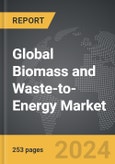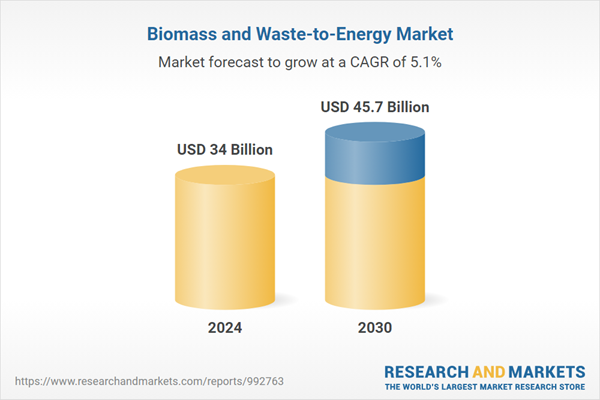The global market for Biomass and Waste-to-Energy was valued at US$34.0 Billion in 2024 and is projected to reach US$45.7 Billion by 2030, growing at a CAGR of 5.1% from 2024 to 2030. This comprehensive report provides an in-depth analysis of market trends, drivers, and forecasts, helping you make informed business decisions. The report includes the most recent global tariff developments and how they impact the Biomass and Waste-to-Energy market.
The technologies used in biomass and WTE processes are diverse and continuously evolving. Biomass conversion methods include direct combustion, anaerobic digestion, and gasification. Direct combustion involves burning biomass in boilers to produce steam for electricity generation. Anaerobic digestion utilizes microorganisms to break down organic matter in the absence of oxygen, producing biogas that can be used for heat and power. Gasification converts biomass into a syngas through partial oxidation, which can then be used to generate electricity or produce chemicals. Similarly, WTE technologies encompass incineration, pyrolysis, and plasma arc gasification. Incineration involves burning waste at high temperatures to produce steam for power generation. Pyrolysis thermally decomposes organic material at high temperatures in the absence of oxygen, producing bio-oil and syngas. Plasma arc gasification uses electrically generated plasma to convert waste into syngas and slag, minimizing residual waste. These technological advancements enhance the efficiency and environmental performance of biomass and WTE facilities, making them more viable and attractive solutions for modern energy challenges.
The growth in the biomass and waste-to-energy market is driven by several factors, including technological advancements, policy support, and increasing awareness of environmental issues. Technological advancements have significantly improved the efficiency and scalability of biomass and WTE systems, making them more cost-effective and capable of handling larger volumes of waste and biomass. Government policies and incentives, such as tax credits, subsidies, and renewable energy mandates, play a crucial role in promoting the adoption of these technologies. The increasing awareness and concern about environmental issues, particularly climate change and waste management, have spurred both public and private sector investments in biomass and WTE projects. Furthermore, the growing demand for renewable energy sources to meet rising energy needs and the shift towards a circular economy, where waste is minimized, and resources are reused, also contribute to market growth. The integration of smart grid technologies and advancements in material recovery from waste are additional drivers, enabling more efficient and sustainable energy production from biomass and waste resources. Collectively, these factors highlight the dynamic and multifaceted growth of the biomass and waste-to-energy market, emphasizing its critical role in the transition towards a more sustainable and resilient energy future.
Segments: Technology (Thermal; Biological; Other Technologies).
Geographic Regions/Countries: World; USA; Canada; Japan; China; Europe; France; Germany; Italy; UK; Rest of Europe; Asia-Pacific; Rest of World.
The analysts continuously track trade developments worldwide, drawing insights from leading global economists and over 200 industry and policy institutions, including think tanks, trade organizations, and national economic advisory bodies. This intelligence is integrated into forecasting models to provide timely, data-driven analysis of emerging risks and opportunities.
Global Biomass and Waste-to-Energy Market - Key Trends & Drivers Summarized
Biomass and waste-to-energy (WTE) technologies are increasingly recognized as pivotal components of sustainable energy strategies. Biomass refers to organic material derived from plants and animals, which can be used directly as fuel or converted into biofuels through various processes. Common sources include agricultural residues, forestry by-products, and dedicated energy crops. Waste-to-energy, on the other hand, involves the conversion of municipal solid waste (MSW) into usable heat, electricity, or fuel. This process not only helps in managing waste but also in generating renewable energy, thereby addressing two critical issues simultaneously: waste management and energy production. The integration of these technologies supports the reduction of greenhouse gas emissions and reliance on fossil fuels, contributing significantly to environmental sustainability and energy security.The technologies used in biomass and WTE processes are diverse and continuously evolving. Biomass conversion methods include direct combustion, anaerobic digestion, and gasification. Direct combustion involves burning biomass in boilers to produce steam for electricity generation. Anaerobic digestion utilizes microorganisms to break down organic matter in the absence of oxygen, producing biogas that can be used for heat and power. Gasification converts biomass into a syngas through partial oxidation, which can then be used to generate electricity or produce chemicals. Similarly, WTE technologies encompass incineration, pyrolysis, and plasma arc gasification. Incineration involves burning waste at high temperatures to produce steam for power generation. Pyrolysis thermally decomposes organic material at high temperatures in the absence of oxygen, producing bio-oil and syngas. Plasma arc gasification uses electrically generated plasma to convert waste into syngas and slag, minimizing residual waste. These technological advancements enhance the efficiency and environmental performance of biomass and WTE facilities, making them more viable and attractive solutions for modern energy challenges.
The growth in the biomass and waste-to-energy market is driven by several factors, including technological advancements, policy support, and increasing awareness of environmental issues. Technological advancements have significantly improved the efficiency and scalability of biomass and WTE systems, making them more cost-effective and capable of handling larger volumes of waste and biomass. Government policies and incentives, such as tax credits, subsidies, and renewable energy mandates, play a crucial role in promoting the adoption of these technologies. The increasing awareness and concern about environmental issues, particularly climate change and waste management, have spurred both public and private sector investments in biomass and WTE projects. Furthermore, the growing demand for renewable energy sources to meet rising energy needs and the shift towards a circular economy, where waste is minimized, and resources are reused, also contribute to market growth. The integration of smart grid technologies and advancements in material recovery from waste are additional drivers, enabling more efficient and sustainable energy production from biomass and waste resources. Collectively, these factors highlight the dynamic and multifaceted growth of the biomass and waste-to-energy market, emphasizing its critical role in the transition towards a more sustainable and resilient energy future.
Report Scope
The report analyzes the Biomass and Waste-to-Energy market, presented in terms of units. The analysis covers the key segments and geographic regions outlined below.Segments: Technology (Thermal; Biological; Other Technologies).
Geographic Regions/Countries: World; USA; Canada; Japan; China; Europe; France; Germany; Italy; UK; Rest of Europe; Asia-Pacific; Rest of World.
Key Insights:
- Market Growth: Understand the significant growth trajectory of the Thermal segment, which is expected to reach US$36.4 Billion by 2030 with a CAGR of a 4.9%. The Biological segment is also set to grow at 5.9% CAGR over the analysis period.
- Regional Analysis: Gain insights into the U.S. market, valued at $6.0 Billion in 2024, and China, forecasted to grow at an impressive 6.1% CAGR to reach $7.5 Billion by 2030. Discover growth trends in other key regions, including Japan, Canada, Germany, and the Asia-Pacific.
Why You Should Buy This Report:
- Detailed Market Analysis: Access a thorough analysis of the Global Biomass and Waste-to-Energy Market, covering all major geographic regions and market segments.
- Competitive Insights: Get an overview of the competitive landscape, including the market presence of major players across different geographies.
- Future Trends and Drivers: Understand the key trends and drivers shaping the future of the Global Biomass and Waste-to-Energy Market.
- Actionable Insights: Benefit from actionable insights that can help you identify new revenue opportunities and make strategic business decisions.
Key Questions Answered:
- How is the Global Biomass and Waste-to-Energy Market expected to evolve by 2030?
- What are the main drivers and restraints affecting the market?
- Which market segments will grow the most over the forecast period?
- How will market shares for different regions and segments change by 2030?
- Who are the leading players in the market, and what are their prospects?
Report Features:
- Comprehensive Market Data: Independent analysis of annual sales and market forecasts in US$ Million from 2024 to 2030.
- In-Depth Regional Analysis: Detailed insights into key markets, including the U.S., China, Japan, Canada, Europe, Asia-Pacific, Latin America, Middle East, and Africa.
- Company Profiles: Coverage of players such as Agrigas Energy S.A., Babcock & Wilcox Enterprises, Inc., Future Biogas Limited, Hitachi Zosen Corporation, ITOCHU Corporation and more.
- Complimentary Updates: Receive free report updates for one year to keep you informed of the latest market developments.
Some of the 58 companies featured in this Biomass and Waste-to-Energy market report include:
- Agrigas Energy S.A.
- Babcock & Wilcox Enterprises, Inc.
- Future Biogas Limited
- Hitachi Zosen Corporation
- ITOCHU Corporation
- Keppel Corporation
- Licella Holdings Ltd.
- Marubeni Corporation
- Mitsubishi Heavy Industries Ltd.
- The EDF Group
- Veolia Environnement S.A.
- Wartsila Corporation
Tariff Impact Analysis: Key Insights for 2025
Global tariff negotiations across 180+ countries are reshaping supply chains, costs, and competitiveness. This report reflects the latest developments as of April 2025 and incorporates forward-looking insights into the market outlook.The analysts continuously track trade developments worldwide, drawing insights from leading global economists and over 200 industry and policy institutions, including think tanks, trade organizations, and national economic advisory bodies. This intelligence is integrated into forecasting models to provide timely, data-driven analysis of emerging risks and opportunities.
What’s Included in This Edition:
- Tariff-adjusted market forecasts by region and segment
- Analysis of cost and supply chain implications by sourcing and trade exposure
- Strategic insights into geographic shifts
Buyers receive a free July 2025 update with:
- Finalized tariff impacts and new trade agreement effects
- Updated projections reflecting global sourcing and cost shifts
- Expanded country-specific coverage across the industry
Table of Contents
I. METHODOLOGYII. EXECUTIVE SUMMARY2. FOCUS ON SELECT PLAYERSIII. MARKET ANALYSISREST OF WORLDIV. COMPETITION
1. MARKET OVERVIEW
3. MARKET TRENDS & DRIVERS
4. GLOBAL MARKET PERSPECTIVE
UNITED STATES
CANADA
JAPAN
CHINA
EUROPE
FRANCE
GERMANY
ITALY
UNITED KINGDOM
REST OF EUROPE
ASIA-PACIFIC
INDIA
AUSTRALIA
LATIN AMERICA
Companies Mentioned (Partial List)
A selection of companies mentioned in this report includes, but is not limited to:
- Agrigas Energy S.A.
- Babcock & Wilcox Enterprises, Inc.
- Future Biogas Limited
- Hitachi Zosen Corporation
- ITOCHU Corporation
- Keppel Corporation
- Licella Holdings Ltd.
- Marubeni Corporation
- Mitsubishi Heavy Industries Ltd.
- The EDF Group
- Veolia Environnement S.A.
- Wartsila Corporation
Table Information
| Report Attribute | Details |
|---|---|
| No. of Pages | 253 |
| Published | April 2025 |
| Forecast Period | 2024 - 2030 |
| Estimated Market Value ( USD | $ 34 Billion |
| Forecasted Market Value ( USD | $ 45.7 Billion |
| Compound Annual Growth Rate | 5.1% |
| Regions Covered | Global |









